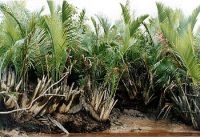 According to recent press reports, a Malaysian company, Pioneer Bio Industries Corp. Sdn. Bhd., is about to begin building what it claims will be the world’s first plant to commercially produce fuel ethanol from nipah palms (Nypa fruiticans), also known as the mangrove palm, attap palm (in Singapore), and Golpata (in Bangladesh).
According to recent press reports, a Malaysian company, Pioneer Bio Industries Corp. Sdn. Bhd., is about to begin building what it claims will be the world’s first plant to commercially produce fuel ethanol from nipah palms (Nypa fruiticans), also known as the mangrove palm, attap palm (in Singapore), and Golpata (in Bangladesh).
Nipah palms grow in soft mud along coasts and slow-moving tidal rivers flowing into the Indian and Pacific Oceans. They are abundant in Malaysia.
An alcoholic beverage made by fermenting the sap, called tuba sa nipa, has long been popular in the region. Production of ethanol for fuel would be intended mainly for export to countries looking for alternatives to gasoline.
In stark contrast with oil palm, expansion of which (in part to produce biodiesel) has been blamed for deforestation on Borneo, could the harvesting of sap from the nipah palm actually encourage the protection of tropical coastal zones and the development of a profitable business for people living in them?
As reported by the Associated Press:
Company chairman Badrul Shah Mohamad Noor said the company plans to build more than a dozen additional plants over the next five years. He said the technology was developed by 16 Malaysian scientists over the last five years. …
The first plant, costing 1.4 billion ringgit ($398 million), will have a capacity to process 530 million liters (140 million gallons) of ethanol per year. It is expected to be operational at end-2008, Badrul Shah told reporters.
He said the Perak state government has awarded the company the rights to harvest nipah sap on 10,000 hectares of land, for which it has to pay 324 million ringgit ($92.2 million) a year.
I don’t know (yet) whether any subsidies are involved.
According to Wikipedia, the nipah palm has a high, sugar-rich sap yield. “Fermented into ethanol, the palm’s large amount of sap may allow for the production of 15,000 to 20,000 liters of the biofuel per hectare (compare with sugarcane at 5000-8000 liters, or corn, at 2000 liters).”
If anybody has more information on this, I’d be interested!
 According to recent press reports, a Malaysian company, Pioneer Bio Industries Corp. Sdn. Bhd., is about to begin building what it claims will be the world's first plant to commercially produce fuel ethanol from nipah palms (Nypa fruiticans), also known as the mangrove palm, attap palm (in Singapore), and Golpata (in Bangladesh).
According to recent press reports, a Malaysian company, Pioneer Bio Industries Corp. Sdn. Bhd., is about to begin building what it claims will be the world's first plant to commercially produce fuel ethanol from nipah palms (Nypa fruiticans), also known as the mangrove palm, attap palm (in Singapore), and Golpata (in Bangladesh).

